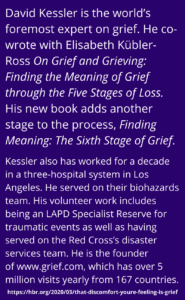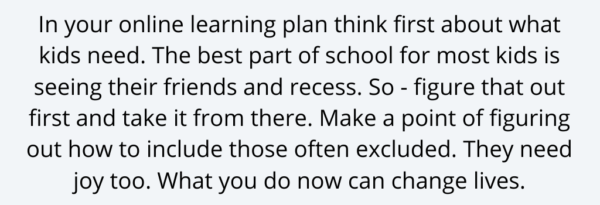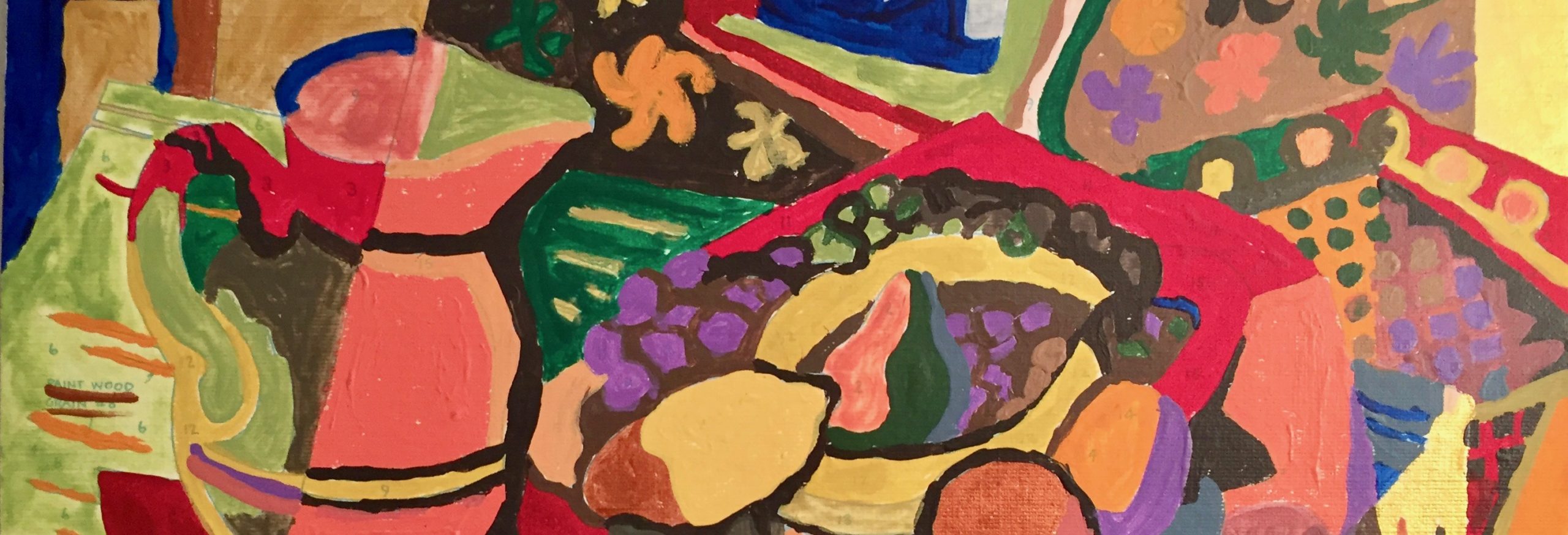What Schools Have To Be About Now
 A colleague shared an article – That Discomfort You’re Feeling Is Grief from the Harvard Business Review and it struck a chord.
A colleague shared an article – That Discomfort You’re Feeling Is Grief from the Harvard Business Review and it struck a chord.
Suddenly – with the pandemic – the future, that had been lurking and looming on a horizon in plain sight, had arrived all at once. And everything was different and everything needed to be rethought and everything was a shock.
The article is in the form of an interview with David Kessler
HBR: People are feeling any number of things right now. Is it right to call some of what they’re feeling grief?
Kessler: Yes, and we’re feeling a number of different griefs. We feel the world has changed, and it has. We know this is temporary, but it doesn’t feel that way, and we realize things will be different. Just as going to the airport is forever different from how it was before 9/11, things will change and this is the point at which they changed. The loss of normalcy; the fear of economic toll; the loss of connection. This is hitting us and we’re grieving. Collectively. We are not used to this kind of collective grief in the air.
The Gloom
What we also feeling – Kessler says – is anticipatory grief – the worry about a VUCA future where everything is volatile, uncertain, complex and ambiguous. We know something bad is on the way – the apex of the curves of infection, hospitalizations, deaths. The worst is yet to come.
We feel the more direct impact of a virus that steals ever more closely into our lives affecting everything and where a simple act of buying groceries is a life or death struggle with an unseen enemy out to maybe kill you with one simple mistake. It’s stressful and confusing. Kessler calls this grieving on micro and a macro level.
And so my mind started revving up and spinning out with ideas.
All is Not Lost
There are things individuals and as schools can do that can help. And most of that has to do with that realization: There are things we can do, we must do, to cope. Kessler outlines the muddled emotional journey to that end. The things we can’t control and the things we can. Denial, anger, bargaining, sadness all pile in. And then we arrive at: Well, here we are, better get on with it and make that lemonade.
Acceptance, as you might imagine, is where the power lies. We find control in acceptance. I can wash my hands. I can keep a safe distance. I can learn how to work virtually.
So the mind races through fear, and anxiety and panic and round again – seeking balance, an equilibrium of emotion, that allows us to move beyond helpless paralysis and into doing. Into doing what we can to stabilize our feelings and get things done. It’s about drawing back from the terror of anticipated scenarios and into the here and now where not everything is lost and there is room to act – wash your hands, keep your distance, bake bread, read about The Black Death, oil that squeaky door hinge, write King Lear, do the laundry, call a friend.
The Doom
But while all this is going on – the sickness, the suffering, lives lost – there is a wider context for that grief. Not only have we lost our daily routines, freedom of movement and social interactions we also appear to have lost our country.
While we struggle to maintain personal and institutional equilibrium we also see a rudderless nation that has been reckless with our future and a leader who has conducted himself in ways – consistent with his character and past history – that is divisive, destructive and depraved.
The Hope
So that’s depressing.
But as Mr. Rogers always told children faced with tragedy and disaster: “Look to the helpers!” Look to the people close by and to people with power – to the politicians and the leaders who are motivated not by narcissistic and vengeful greed but by the desire to plan for a better future for all. And there are people who do know what to do to move us forward in ways consistent with our nation’s better angels. Let’s look to them and lend support.
What Schools Can Do
Schools are pitching themselves headlong into distance learning and taking on the steep learning curve of going digital. The trap is to forget what we know about how children learn and fall into a groove delivering content. So easy to do with technology.
Parcels and Pizza Get Delivered. Learning Does Not
Learning is about trial and error and engagement and community and relationships. It’s about agency and choice and ownership and discovery and connection. And joy.
The number one challenge for schools going on line is to focus first on the things that matter most. And that means thinking about how each child is faring. Not grading and assessment and academic integrity and whatever triviality froths up.

Now Is The Time to Take All That Responsive Classroom and Social Emotional Learning Online
The focus first must be, has to be, on meeting students where they are and helping them and their families cope by creating community and establishing relationships and routines that bring students together to connect and engage with matters of meaning and purpose that have value now.
This is the perfect time to stop obsessing on grading; tests; scores; GPAs; worksheets; assignments; rigid deadlines; book reports and five paragraph essays. Focus instead on learners and their needs for safe places to continue to grow and learn, be together and find meaning and joy. Take it from there.
So that’s the learning bit – the challenge to build on existing connections, maintain community, forge ties, be aware of individual needs and get students engaged.
And what an opportunity to focus on authenticate real world problems! The kids are surrounded by them in their own homes. Get those student minds cranking on naming needs/problems that they can help resolve – their own, their family’s and others they know, have heard about or can imagine. And think of the transdisciplinary opportunities: Statistics; poetry; media analysis, bias and distortion; artistic representation and expression; equity and justice; PSAs; biology; literary perspectives; historical precedents;, global contrasts; political science; epidemiology; escapism and how to stay level headed in a time of grief and anxiety.
Can older students form reading buddy groups with younger ones.? Who has figured out an effective home made hand sanitizer for the designated shopper? How to cope with no toilet paper? Best ways to cheer up a friend? Twenty ways to cook that stockpile of pasta? What can you send electronically to help your older relatives feel less lonely? Who doesn’t have anyone to talk to? How to give everyone the privacy they need. How to stay fit. And all the rest of it. What can you make with two cardboard boxes and a piece of duct tape? How do you establish a fair distribution of household chores?
The kids know the problems already. How can they work on their solutions together? And teachers the same. Free them up to be imaginative and playful as well as caring and connected.
And then of course there’s the regular academic curriculum. Those familiar routines can help. How do you keep that going in developmentally appropriate ways? What parts still even make sense? Learn the lessons along the way of what actually mattered in a time of crisis. And what did not.
And here’s more good advice from the Teaching Tolerance folks:;
A Trauma-Informed Approach to Teaching Through Coronavirus
The What If School
So that’s all done and dusted and the parents reassured and fully communicated with. (Easy, right?)
Now to the harder part: You don’t know what’s going to happen. But you must plan for it. The future may be unthinkable. But you must think about it.
School Finances in a Time of Crisis
Money in. Money out. What are your school’s sources of revenue and how are they affected now and might be in the future.
And for most independent schools that means tuition and enrollment.
To consider in no particular order:
- How is your revenue stream affected? For this year? And projected 2020-2021?
- What happens if enrollment / net tuition revenue drops by 10%,? By 20%? More?
- How solid was the financial footing before and where is now and where might it be in the future?
- What does the endowment look like given the stock market? What does that mean for you?
- What does that mean for any future required, automatic, or discretionary draw downs from restricted and unrestricted funds?
- What decisions do you make about and commitments to faculty and staff for this year.
- What contingencies do you need to add to contracts/ letters of agreement for next year?
- What are the operation savings from this year? Food service; electricity; heat and a/c; transportation; athletics; professional development and event expenses.
- Vendor contracts? Binding for the year? Or non-binding. Can you re-negotiate?
- Any additional expenses?
- What revenue losses? After school/ summer programs.
- Where are you with enrollment? With new enrollment? What do the tea leaves tell you?
- How must you budget for best case, worst case and the Goldilocks scenarios?
- What can you drop, shrink, combine, adapt and consolidate from your expense lines?
- What about expanded financial aid? How can ant increased financial aid be structured as a short time measure and not a long term millstone? How do you focus on net revenue, maintain numbers and operate at capacity while also not planting a Trojan horse of long-term depleted revenue.
- On what basis will you offer increased financial aid. Should you create an Emergency Aid fund? Can you fund-raise around that? Would the effect be just to switch philanthropic giving rather than increase it? What would be the effect of that?
- How do you ensure that faculty -who have probably worked all through spring break preparing to go online -get the practical and emotional resources they need. How do you help sustain and build capacity and community and reduce isolation and anxiety.
- Are you lucky enough to be able to over enroll in order to meet potential enrollment fall-off?
- What if this is the new normal and school does not open in September? What does your school like and can you continue to operate?
- Has your value proposition changed? Has it adapted? Can you “deliver” current mission? How well are you communicating that?
- How will you handle a family who asks for a refund for school time lost this year? Can you legitimately make the case that school is continuing in spite of the emergency?
- Will families be moving into your area? Or out of it? How is local employment affected short and long term?
- What do people seek for their children in times of stress and uncertainty
- How can your school be the answer to their problems? How can you find out what they are?
- How can you take this opportunity to establish school principles and practices on sound mission-consistent pedagogical principles
- How will international enrollment be affected by the pandemic?
- How do you market and do outreach in a time of isolation and shelter-in-place?
- How can the school become a useful resource for families in a time of crisis?
- How do you go through the steps for downsizing/ rightsizing the school? Is every function and program essential?
- How is this moment an opportunity to do the right things? To act on the bold ideas and make long needed needed change?
- How to maintain what was truly valuable when the circumstances make it difficult.
- What does a virtual commencement and other community celebrations look like on line? Can they be deferred to – say – August?
- What do you keep at all costs and what can you led slide from view as you reimagine a future, truly based on and educational vision and your mission and values.
The Guide to the Agony and Opportunity of School Right-Sizing may be helpful
Here’s a guide from ISM on Private Schools and the CARES Stimulus Package
Best advice:
Create a leadership team and a task force and lead with the teams. The buck may stop with the individual but the work, the ideas, the responsibility and the credit must be shared and co-owned.
Everything we do before a pandemic will seem alarmist. Everything we do will afterwards seem inadequate.
Learning is about trial and error. Celebrate successes and cheer on effort and progress.
You don’t have to be perfect. And any way – you won’t be and nor will anyone else. Support the rising tide that lifts all boats and make sure no-one is anchored to the seabed on a short cable. Spout clichés and mix your metaphors with impunity. And don’t forget to laugh.
The Glory?
And the glory? What about the glory? When does that get handed around?
Well there won’t be any glory. But we will get through this in spite of the unimaginable losses and grief. And that will be enough.
So good luck to all you educators taking on this challenge. Your courage creativity kindness and caring are needed now more than ever. You can do this. And it will be perfectly, imperfect and glorious. Thank-you.





Such wisdom across the board, Josie. I’m passing this on to some teacher friends of mine. You have it (with IT, the Horror Clown) much worse than we do, but in both countries, we’re seeing the grassroots network kick in. Same old story – useless (or malign) governments, people actually doing the right thing (for us a pleasant change from Brexit, though of course this shouldn’t be wished on anyone).
Yes – it does make Brexit seem like the distant past. In fact – time itself seems changed. And while I have time to spare every moment seems more important. Odd.
Great post, Josie. It is a challenging time for schools, and especially for the kids. You offer wonderful words of encouragement and some great suggestions. Hope you are doing well.